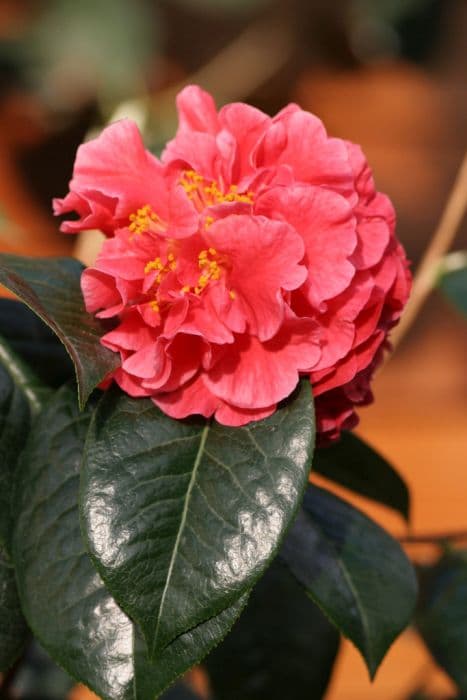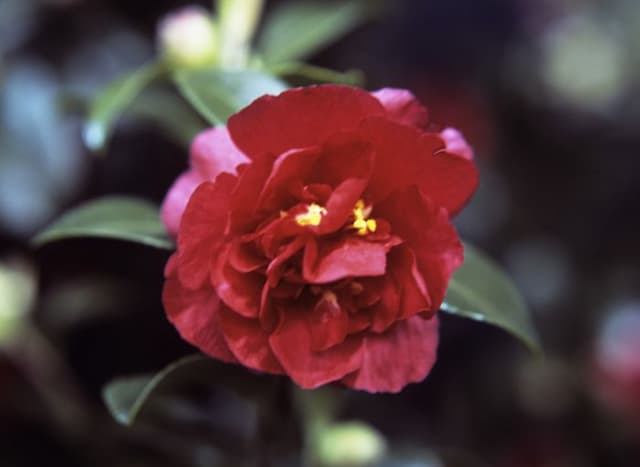Japanese Camellia Camellia japonica 'Sylva'

ABOUT
Camellia japonica 'Sylva', commonly referred to as Camellia, is a plant that is cherished for its gorgeous blooms and glossy evergreen foliage. The flowers of this Camellia variety are characteristically large with a layered petal arrangement, giving them a full and ruffled appearance. The blooms are a deep, rich pink color and can have a velvety texture, providing a stunning contrast against the dark green leaves. The foliage of 'Sylva' itself is leathery and shiny, maintaining an attractive dark green color throughout the year. Leaves are typically oval-shaped with a slightly serrated edge, adding subtle texture to the plant's appearance. The combination of the vibrant flowers against the lush green backdrop makes it a favorite among gardeners and landscape designers for adding a splash of color to gardens. It is commonly used as an ornamental plant in residential and commercial landscapes, and can be found adorning gardens and parks.
About this plant
 Names
NamesFamily
Theaceae.
Synonyms
Japanese Camellia, Common Camellia, Japonica.
Common names
Camellia japonica 'Sylva'
 Toxicity
ToxicityTo humans
Camellia japonica, commonly known as the Japanese camellia, is not considered poisonous to humans. There are no well-documented cases of toxicity from ingesting parts of this plant, and it is generally regarded as safe. However, as with any plant material, it is always possible for individuals to have allergic reactions or for specific parts of the plant to cause gastrointestinal upset if ingested in large quantities.
To pets
The Japanese camellia is not known to be toxic to pets, such as dogs and cats. This means that the ingestion of parts of the plant is not expected to cause serious harm or poisoning symptoms in pets. However, as with humans, individual animals might have varying sensitivities, and the consumption of non-food items can sometimes lead to gastrointestinal discomfort or blockages, depending on the quantity ingested.
 Characteristics
CharacteristicsLife cycle
Perennials
Foliage type
Evergreen
Color of leaves
Dark green
Flower color
Pink
Height
6-12 feet (1.8-3.6 meters)
Spread
6-10 feet (1.8-3 meters)
Plant type
Shrub
Hardiness zones
7-9
Native area
Japan
Benefits
 General Benefits
General Benefits- Ornamental Appeal: Camellia japonica 'Sylva' offers vibrant, showy flowers that enhance garden aesthetics.
- Year-Round Interest: With its evergreen foliage, it provides continuous greenery throughout the year.
- Diverse Landscaping Uses: Suitable for use as a specimen plant, hedge, or in mass plantings.
- Shade Tolerance: Thrives in partially shaded conditions, making it ideal for understory planting.
- Drought Resistance: Once established, it can tolerate periods of dry weather.
- Wildlife Habitat: Provides shelter and foraging opportunities for birds and beneficial insects.
- Low Maintenance: Requires minimal pruning and care once established.
- Cultural Significance: Often used in traditional gardens and has cultural importance in certain regions.
 Medical Properties
Medical PropertiesThis plant is not used for medical purposes.
 Air-purifying Qualities
Air-purifying QualitiesThis plant is not specifically known for air purifying qualities.
 Other Uses
Other Uses- Camellia japonica 'Sylva', commonly known as the Japanese camellia, can be used in bonsai cultivation due to its beautiful flowers and the ability to shape its growth into an aesthetically pleasing miniature form.
- The petals of the Japanese camellia can be utilized in crafting natural dyes for fabrics, providing a range of soft pink hues.
- Wood from the Japanese camellia is hard and can be polished to a high sheen, making it suitable for creating small woodcraft items like handles for tools and utensils.
- The fallen petals of the Japanese camellia can serve as a visually appealing and natural mulch in garden beds, slowly breaking down to enrich the soil.
- Petals of the Japanese camellia can be added to bathwater for a luxurious and fragrant bathing experience, enhancing relaxation.
- This plant's prolonged flowering period provides a valuable nectar source for pollinators during the early spring when other food sources are scarce.
- Camellia japonica 'Sylva' can be used in floral arrangements and Ikebana, the Japanese art of flower arrangement, due to its elegant form and vivid blossoms.
- The leaves of the Japanese camellia can be simmered to create a fragrant and soothing room simmer, imparting a delicate scent throughout the home.
- Pressed flowers and leaves from the Japanese camellia can be used in artistic applications, such as creating bookmarks, greeting cards, or in decoupage projects.
- Camellia japonica 'Sylva' provides an excellent backdrop in thematic gardens, particularly in Asian-inspired garden designs due to its origin and traditional significance.
Interesting Facts
 Feng Shui
Feng ShuiThe Camellia is not used in Feng Shui practice.
 Zodiac Sign Compitability
Zodiac Sign CompitabilityThe Camellia is not used in astrology practice.
 Plant Symbolism
Plant Symbolism- Adoration and Devotion: Camellia japonica 'Sylva', commonly known as Camellia, often symbolizes deep adoration and devotion due to its rich and full-bodied blooms that convey heartfelt emotions.
- Perfection and Excellence: The Camellia's exquisite and flawless flowers are associated with perfection and the pursuit of excellence, embodying the beauty and consistency in nature.
- Longevity and Steadfastness: As an evergreen with a long blooming season, the Camellia represents longevity and the steadfast nature of life, suggesting endurance through all seasons.
- Love and Affection: The Camellia is commonly gifted as a symbol of love and affection, with its luxurious petals and alluring fragrance, it is a perfect emblem of romantic emotions.
- Pride: With its noble appearance and association with high-standing virtues, the Camellia can convey a sense of pride, whether in one's accomplishments or in sharing beauty with others.
 Water
WaterThe Japanese Camellia should be watered thoroughly and deeply when the top inch of the soil feels dry to the touch, typically once a week, but this can vary with climate conditions. During the growing season, spring to fall, water with about 1 to 1.5 gallons per week for each plant, ensuring that water penetrates the root zone. Reduce watering in the winter when the plant is not actively growing. Overhead watering isn't recommended, because it can promote leaf diseases; instead, water at the base of the plant to keep the foliage dry.
 Light
LightJapanese Camellias thrive in partially shaded locations where they receive dappled sunlight or only morning sun, as they are prone to leaf scorch from too much direct afternoon sun. They perform best in a spot that is protected from strong winds and the hot afternoon sun, which can cause their delicate blooms to fade prematurely.
 Temperature
TemperatureJapanese Camellias prefer temperate climates with temperatures ranging between 60°F and 80°F for optimal growth. They are hardy and can survive brief dips down to at least 20°F but should be protected from frost to prevent damage to the flowers. Prolonged exposure to temperatures above 85°F can impede their growth and flowering.
 Pruning
PruningPrune Japanese Camellias to maintain shape and remove any dead or weak wood, which helps improve air circulation and overall health. The best time to prune is just after the blooms have faded, typically in spring, but avoid heavy pruning as this can reduce the following year's blooms. Pruning every year is not necessary, though light pruning can be beneficial if performed annually.
 Cleaning
CleaningAs needed
 Soil
SoilThe Japanese Camellia 'Sylva' prospers in acidic soil with a pH range of 5.0 to 6.5. An ideal soil mix would consist of 1/3 organic matter such as peat moss or leaf mold, 1/3 garden soil, and 1/3 perlite or vermiculite, ensuring good drainage and aeration.
 Repotting
RepottingJapanese Camellias, including 'Sylva', generally need repotting every 2-3 years. Choose a slightly larger pot each time to accommodate root growth, and repot in late winter or early spring before new growth begins.
 Humidity & Misting
Humidity & MistingCamellias like 'Sylva' prefer moderate to high humidity levels. Aim for around 40-60% relative humidity for optimal growth, which may involve using a humidifier or pebble tray to maintain appropriate conditions.
 Suitable locations
Suitable locationsIndoor
Ensure bright, indirect light and maintain stable temperatures.
Outdoor
Place in partial shade, protect from strong winds and cold snaps.
Hardiness zone
7-9 USDA
 Life cycle
Life cycleCamellia japonica 'Sylva', commonly known as the Japanese camellia, begins its life cycle as a seed, which germinates to produce a small seedling with just a few leaves. As it grows into a young plant, it develops a woody stem and a root system that allows it to absorb nutrients and water from the soil. When mature, the Japanese camellia blooms annually, typically between winter and spring, producing large, showy flowers that vary in color from white to pink and red. After pollination, which is often aided by insects such as bees, the flowers produce seeds that are then dispersed to grow into new plants. Between flowering seasons, the plant enters a period of vegetative growth, where it focuses on leaf and stem development to increase its photosynthetic capacity for the next blooming cycle. Finally, as a perennial, the Japanese camellia can live for many years, going through repeated cycles of growth, flowering, and seed production.
 Propogation
PropogationPropogation time
Spring-Early Summer
Camellia japonica 'Sylva', commonly known as Camellia, is most commonly propagated by semi-ripe cuttings taken in late summer or early fall. To do this, select healthy shoot tips of about 4 to 6 inches (10 to 15 cm) long that have started to harden at the base. The leaves at the lower half of the cutting should be removed, and the cut end can be dipped in rooting hormone to encourage root development. The cutting is then inserted into a mixture of peat and perlite or a fine sand and kept under high humidity with bottom heat around 75 degrees Fahrenheit (24 degrees Celsius). It usually takes several months for the cutting to root, and during this period, it should be kept in indirect light and monitored for moisture levels to ensure the cutting does not dry out or become waterlogged.









